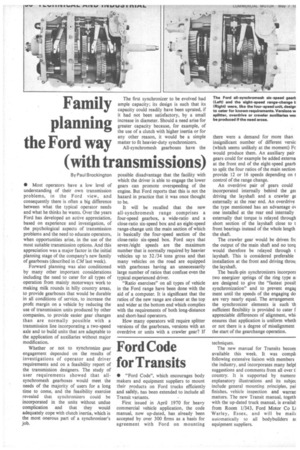• Family planning the Ford way (with transmissions)
Page 52

If you've noticed an error in this article please click here to report it so we can fix it.
By Paul Brockington • Most operators have a low level of understanding of their own transmission problems, in the Ford view, and consequently there is often a big difference between what the typical operator needs and what he thinks he wants. Over the years Ford has developed an active appreciation, based on experience and investigation, of the psychological aspects of transmission problems and the need to educate operators, when opportunities arise, in the use of the most suitable transmission options. And this appreciation was a major factor in the initial planning stage of the company's new family of gearboxes (described in CM last week).
Forward planning was also conditioned by many other important considerations including the need to cater for all types of operation from mainly motorways work to making milk rounds in hilly country areas, to provide gearboxes that would be durable in all conditions of service, to increase the profit margin on a vehicle by reducing the use of transmission units produced by other companies, to provide easier gear changes than are normally possible with a transmission line incorporating a two-speed axle and to build units that are adaptable to the application of auxiliaries without major modification.
Whether or not to synchronize gear engagement depended on the results of investigations of operator and driver requirements and on a feasibility report of the transmission designers. The study of user requirements showed that allsynchromesh gearboxes would meet the needs of the majority of users for a long time to come, and the feasibility exercise revealed that synchronizers could be incorporated in the units without undue complication and that they would adequately cope with clutch inertia, which is the most onerous part of a synchronizer's job. The first synchronizer to be evolved had ample capacity; its design is such that its capacity could readily have been uprated, if it had not been satisfactory, by a small increase in diameter. Should a need arise for greater capacity because, for example, of the use of a clutch with higher inertia or for any other reason, it would be a simple matter to fit heavier-duty synchronizers.
All-synchromesh gearboxes have the possible disadvantage that the facility with which the driver is able to engage the lower gears can promote overspeeding of the engine. But Ford reports that this is not the hazard in practice that it was once thought to be.
It will be recalled that the new all-synchromesh range comprises a four-speed gearbox, a wide-ratio and a close-ratio six-speed box and an eight-speed range-change unit the main section of which is basically the four-speed section of the close-ratio six-speed box. Ford says that seven/eight speeds are the maximum number that is normally required by heavier vehicles up to 32/34 tons gross and that many vehicles on the road are equipped with gearboxes having an unnecessarily large number of ratios that confuse even the typical experienced driver.
"Ratio exercises" on all types of vehicle in the Ford range have been done with the aid of a computer. It is significant that the ratios of the new range are closer at the top and wider at the bottom end which complies with the requirements of both long-distance and short-haul operators.
How many operators will require splitter versions of the gearboxes, versions with an overdrive or units with a crawler gear? If
The Ford all-synchromesh six-speed geart (Left) and the eight-speed range-change h (Right} were, like the four-speed unit, design to cater for known requirements. Versions w splitter, overdrive or crawler auxiliaries woo be produced if the need arose.
there were a demand for more than insignificant number of different versic (which seems unlikely at the moment) Fc would produce them. An auxiliary pair gears could for example be added externa at the front end of the eight-speed gearb to split the four ratios of the main section provide 12 or 16 speeds depending on t control of the range change.
An overdrive pair of gears could incorporated internally behind the get driving the layshaft and a crawler ge externally at the rear end. An overdrive the type mentioned has an advantage 61 one installed at the rear end internally externally that torque is relayed through short section of the layshaft close to t front bearings instead of the whole length the shaft.
The crawler gear would be driven frc the output of the main shaft and no torq would therefore be relayed through t layshaft. This is considered preferable installation at the front and driving throu the layshaft.
The baulk-pin synchronizers incorporE two energizer springs of the ring type a] are designed to give the "fastest possil synchronization" and to prevent engag ment until the speeds of the engaging do are very nearly equal. The arrangement the synchronizer elements is such -th sufficient flexibility is provided to cater f appreciable differences of alignment, whil ensures that application is uniform wheth or not there is a degree of misalignment the start of the gearchange operation.










































































































































































































